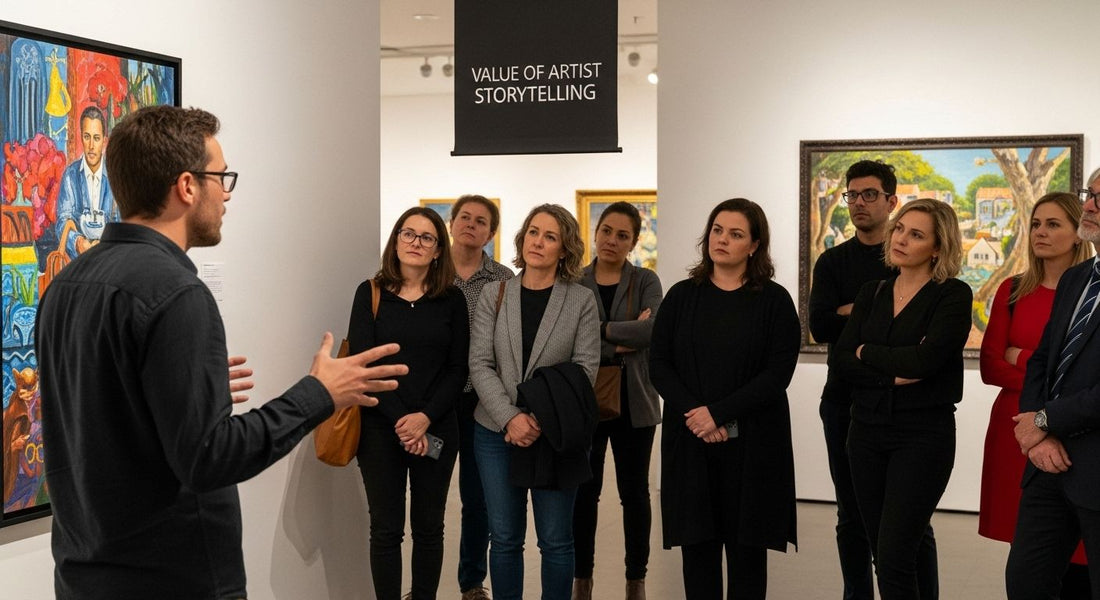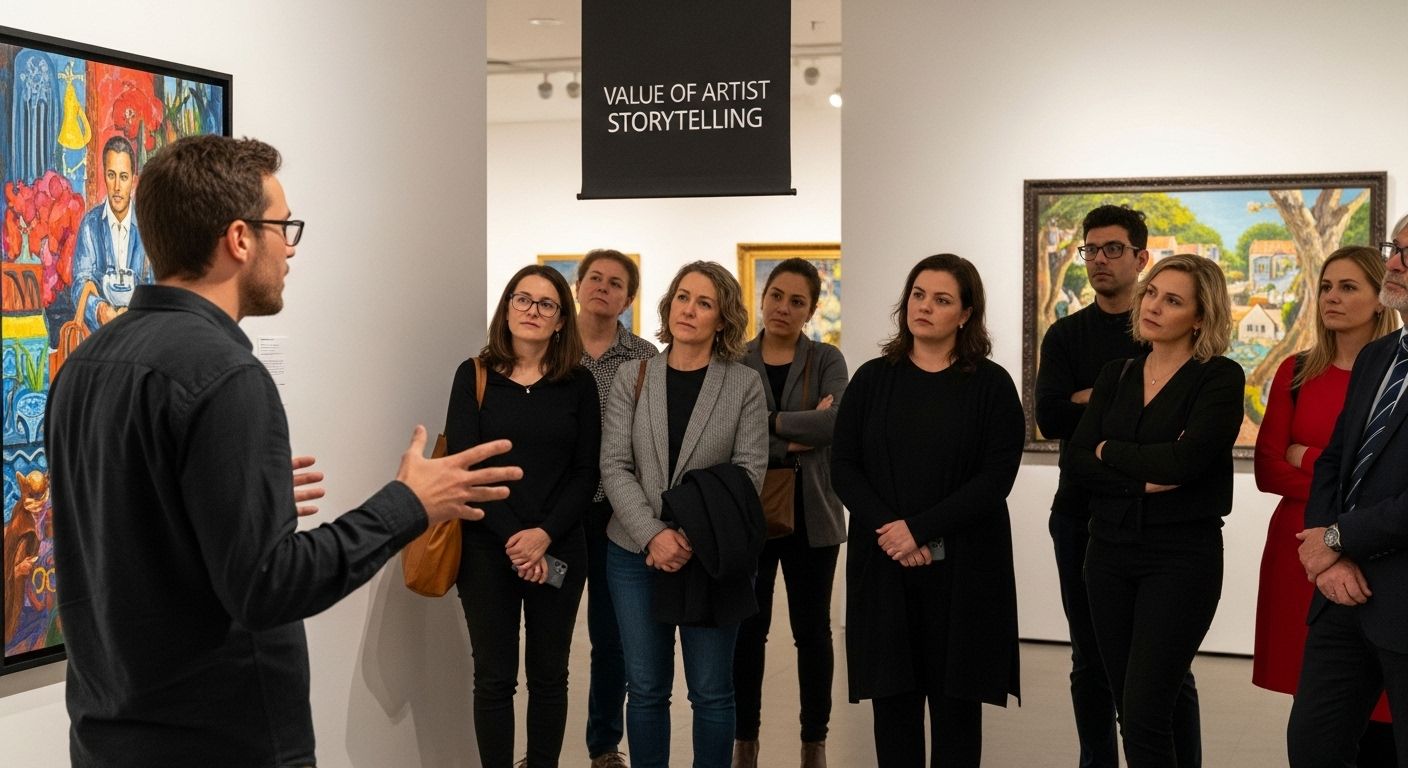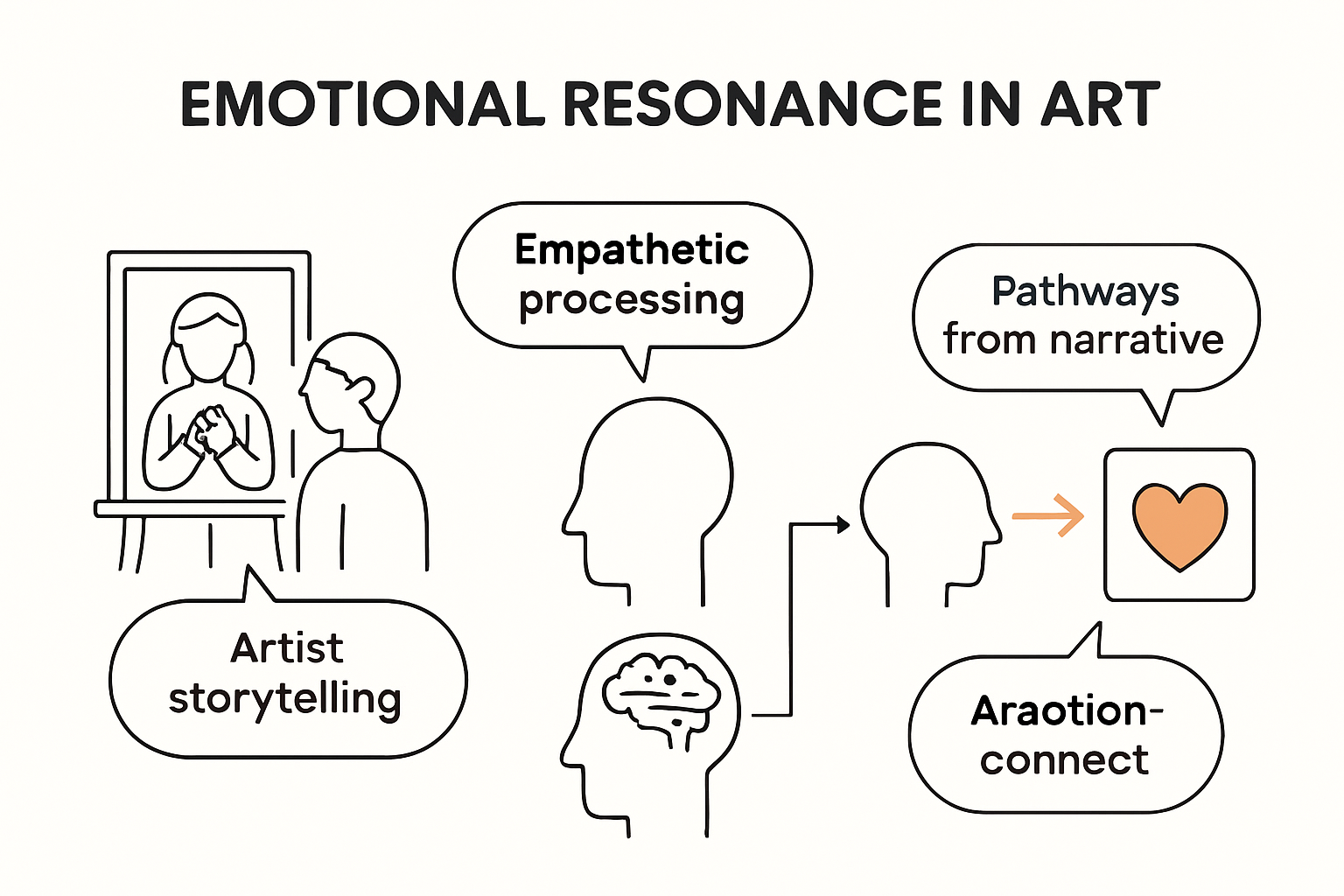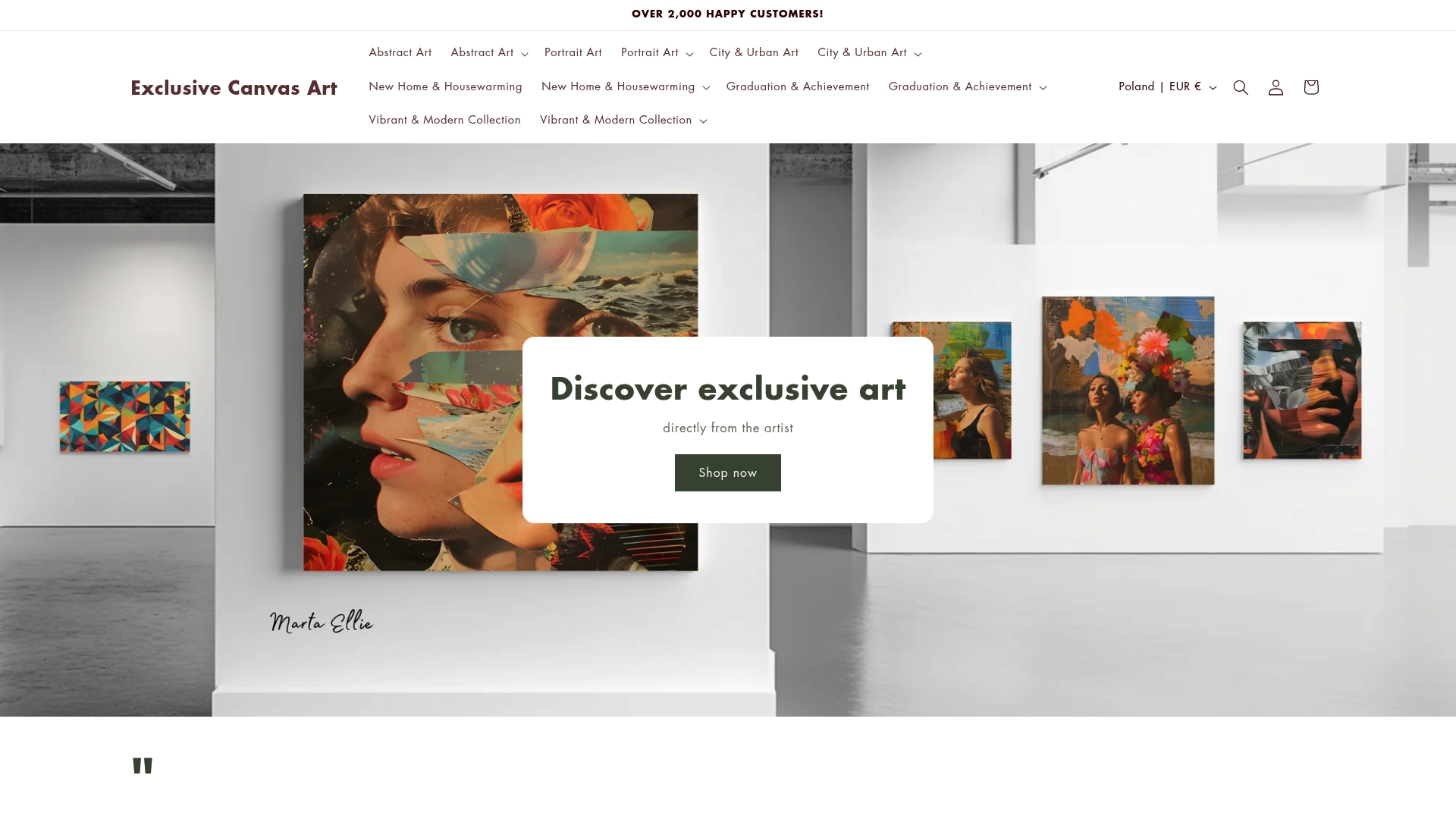
Understanding the Value of Artist Storytelling in Art
Artist storytelling is reshaping how we connect with art. Studies show that artworks with compelling backstories dramatically increase emotional engagement and market value. Most people imagine art is about paint, brushes, and technique. But the story behind the canvas is what turns a painting into a lasting, meaningful experience for both creators and collectors.

Table of Contents
- What Is Artist Storytelling And Its Significance?
- Why The Stories Behind Art Matter To Collectors And Buyers
- How Artist Storytelling Enhances The Emotional Connection
- Key Concepts Of Artist Narratives And Their Impact On Art Appreciation
Quick Summary
| Takeaway | Explanation |
|---|---|
| Artist storytelling connects personal and universal experiences | It allows creators to share unique perspectives, fostering deeper understanding and emotional engagement among viewers. |
| Art narratives enhance emotional and intellectual connections | Compelling backstories turn art into conversation pieces, impacting collectors’ purchasing decisions and appreciation. |
| Rich narratives can increase an artwork’s market value | Art with strong stories often appreciates more consistently, making it attractive to serious collectors and investors. |
| Emotional vulnerability enriches artistic expression | The authenticity of an artist’s journey resonates with viewers, allowing for shared emotional experiences. |
| Effective narratives invite active viewer participation | By engaging with multilayered stories, viewers move beyond passive observation to actively find meaning in art. |
What is Artist Storytelling and Its Significance?
Artist storytelling represents a profound communication method where creators transform personal experiences, emotions, and perspectives into visual narratives through their artwork. More than merely creating aesthetically pleasing images, artist storytelling bridges the intimate inner world of the creator with the broader human experience, inviting viewers into a deeper understanding of context, meaning, and personal journey.
The Core Elements of Artist Storytelling
At its essence, artist storytelling involves several critical components that transform artwork from a visual object into a meaningful communication platform. Visual storytellers craft their narratives through:
- Emotional landscape representation
- Personal experience translation
- Cultural and historical context embedding
- Symbolic language and metaphorical expressions
When artists share their stories, they are not simply displaying technical skill but offering a window into their unique perspective. According to Stanford Arts, storytelling allows artists to create profound connections that transcend traditional aesthetic appreciation, enabling viewers to engage with artwork on intellectual and emotional levels.
To help readers quickly understand the essential elements that define artist storytelling, the table below summarizes its core components as discussed in the article.
| Element | Description |
|---|---|
| Emotional Landscape | Portraying feelings and emotional states within the artwork |
| Personal Experience | Translating individual life events into visual forms |
| Cultural & Historical Context | Embedding references to culture or historic events |
| Symbolic Language | Using metaphors and symbols to deepen meaning |
| Authentic Perspective | Sharing the artist's unique viewpoint or journey |
Significance in Contemporary Art Contexts
In contemporary art environments, storytelling has become increasingly pivotal. Artists are no longer perceived as mere technical creators but as complex narratives generators who communicate complex ideas through visual mediums. The value of artist storytelling extends beyond aesthetic appreciation to include:
- Cultural documentation
- Social commentary
- Personal healing and expression
- Community engagement
The power of artist storytelling lies in its ability to transform personal experiences into universal truths, making individual journeys relatable and meaningful. By sharing vulnerable, authentic narratives, artists create bridges of understanding that connect diverse human experiences, challenging viewers to see the world through different perspectives and emotional landscapes.
Why the Stories Behind Art Matter to Collectors and Buyers
Collectors and art buyers increasingly recognize that the narrative behind an artwork transcends its visual appeal, transforming the piece from a decorative object into a meaningful personal investment. The story embedded within an artwork creates profound emotional and intellectual connections that significantly influence purchasing decisions and long-term art appreciation.
This table organizes the ways in which artist storytelling adds value for both collectors and the broader art market, highlighting emotional, economic, and social dimensions.
| Value Type | How Storytelling Adds Value |
|---|---|
| Emotional | Fosters deeper personal connection and resonance |
| Intellectual | Turns art into a conversation piece and reflection of personal values |
| Economic | Increases market value and long-term appreciation |
| Social/Cultural | Reflects cultural narratives and enables meaningful collection spaces |
| Personal Investment | Allows collectors to acquire meaningful stories, not just objects |
Emotional Investment and Personal Connection
Art buyers are not merely acquiring visual objects but collecting experiences and narratives. When an artwork carries a compelling backstory, it becomes more than a decorative element - it becomes a conversation piece that reflects the collector’s values, interests, and emotional landscape. Research from the National Center for Biotechnology Information demonstrates that contextual information dramatically enhances aesthetic appreciation, particularly for individuals seeking deeper meaning.
Key factors that make art stories compelling include:
- Personal resonance with the artist’s journey
- Representation of unique cultural perspectives
- Exploration of complex emotional landscapes
- Demonstration of exceptional creative processes
Economic and Social Value of Narrative Art
Beyond emotional connections, art stories contribute significant economic and social value. Collectors understand that artworks with rich narratives often appreciate in value more consistently. The provenance and storytelling surrounding an artwork can elevate its market worth, making it more attractive to serious collectors and investors.
Moreover, collecting narrative-rich art allows individuals to explore meaningful art collections that reflect personal identity and intellectual curiosity. By selecting artworks with profound stories, collectors curate spaces that communicate complex ideas and personal values, transforming their environments into dynamic, meaningful exhibitions of human experience.
How Artist Storytelling Enhances the Emotional Connection
Artist storytelling serves as a powerful emotional bridge, transforming visual experiences into deeply personal and profound connections. By revealing the intricate layers of human experience, artists create pathways for viewers to explore complex emotions, personal narratives, and universal truths through their creative expressions.
Psychological Mechanisms of Emotional Resonance
Emotional connections in art emerge through sophisticated psychological processes that go beyond simple visual perception. When viewers encounter artwork embedded with authentic narratives, their brains engage in empathetic processing, activating mirror neurons that enable them to emotionally experience the artist’s intended message. According to psychological research, this neurological response allows individuals to momentarily inhabit alternative perspectives and emotional landscapes.
Key psychological elements that facilitate emotional connections include:

- Vulnerability in artistic representation
- Authenticity of personal narrative
- Universal emotional themes
- Symbolic representation of complex feelings
Transformative Power of Narrative Expression
Artists who masterfully communicate their stories create transformative experiences that transcend traditional aesthetic appreciation. Emotional storytelling through art becomes a form of unspoken communication, allowing viewers to process their own experiences through the lens of another’s perspective. Explore innovative storytelling techniques that reveal how personal narratives can turn artwork into powerful emotional conduits.
By sharing genuine, unfiltered experiences, artists invite viewers into intimate emotional spaces, challenging preconceived notions and expanding emotional intelligence. The artwork becomes more than an object - it transforms into a mirror reflecting shared human vulnerabilities, struggles, and moments of profound connection.
Key Concepts of Artist Narratives and Their Impact on Art Appreciation
Artist narratives represent complex communication systems that transform visual experiences into profound intellectual and emotional journeys. These narratives extend far beyond simple descriptions, serving as intricate frameworks that contextualize artistic creation, enabling deeper understanding and meaningful engagement with creative works.
Fundamental Components of Artistic Narrative
Artist narratives are constructed through multilayered communicative elements that provide insight into the creative process, personal experiences, and philosophical perspectives. Research from the National Center for Biotechnology Information demonstrates that contextual information significantly enhances art appreciation, particularly for viewers seeking deeper comprehension.
Essential components of compelling artist narratives include:
- Personal biographical context
- Emotional motivations behind artwork creation
- Cultural and historical influences
- Technical and conceptual artistic approaches
Narrative Strategies in Artistic Communication
Successful artist narratives employ sophisticated strategies that transform visual experiences into immersive storytelling. These narratives function as interpretive bridges, connecting the artist’s internal world with the viewer’s perceptual landscape. Discover innovative narrative techniques that elevate artistic communication beyond traditional aesthetic boundaries.
By integrating personal vulnerability, cultural insights, and universal emotional experiences, artists create narratives that transcend individual perspectives. These storytelling approaches invite viewers to participate actively in meaning-making, transforming passive observation into an interactive, intellectually stimulating engagement with art.

Experience the Power of Real Artist Storytelling in Your Space
Are you looking for artwork that holds more than just visual beauty? One of the main challenges explored in ‘Understanding the Value of Artist Storytelling in Art’ is connecting with pieces that truly reflect authentic stories and emotional depth. Many collectors and buyers want more than simple decor—they seek meaningful art that transforms their environment and sparks conversation. Marta Ellie’s collections offer exactly this connection, showcasing powerful narratives and genuine emotion. For those who appreciate the emotional resonance and human journey behind each piece, explore the Community Event Participation Art – Exclusive Canvas Art collection, where every creation tells a unique story that goes beyond the surface.

Bring authentic artist storytelling into your home by visiting Marta Ellie’s official site. Immerse yourself in visually stunning canvases that carry real meaning. Start discovering art that not only looks beautiful but speaks to your own experiences. Find your next statement piece and make your space truly personal today.
Frequently Asked Questions
What is artist storytelling?
Artist storytelling is a method where creators transform personal experiences, emotions, and perspectives into visual narratives through their artwork, creating a deeper connection with viewers.
Why does artist storytelling matter in contemporary art?
Artist storytelling is crucial in contemporary art because it helps artists communicate complex ideas, allowing for cultural documentation, social commentary, and individual expression that resonates with audiences.
How does storytelling enhance art appreciation for collectors?
Storytelling enhances art appreciation by creating emotional and intellectual connections between the artwork and the collector, making the piece a representation of personal values and meaningful experiences, which can also increase its market value.
What psychological effects does artist storytelling have on viewers?
Artist storytelling activates empathetic processing in viewers, allowing them to emotionally connect with the artist’s intended message and explore complex emotions and narratives reflected in the artwork.
Recommended
- Narrative in Art Collections: Creating Meaningful Spaces – Exclusive Canvas Art
- Storytelling Through Art: Wall Decor Ideas for 2025 Collectors – Exclusive Canvas Art
- Why Collect Contemporary Art: Value, Decor, and Inspiration 2025 – Exclusive Canvas Art
- Artist Stories Behind Artwork: Inspiring Modern Wall Art 2025 – Exclusive Canvas Art